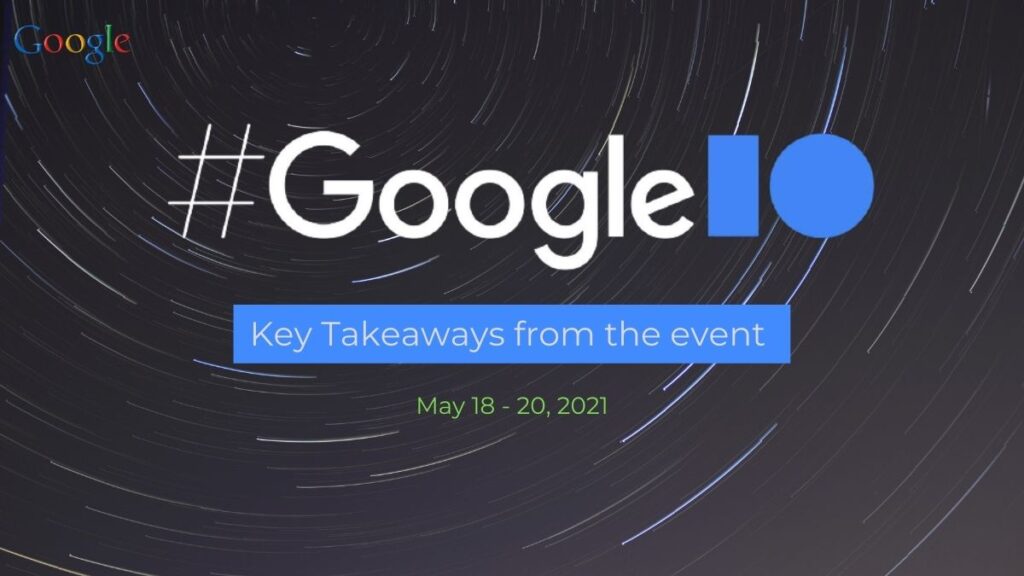Google I/O Event 2021 – Key Updates

Google’s I/O was recently held during May 18-20 after it being cancelled in 2020 owing to the COVID-19 pandemic. Typically, Google uses I/O to show off significant updates to its products, new hardware (in 2019, the company revealed the Pixel 3A and the Nest Hub Max smart display), and occasionally, big initiatives like the AI-powered reservation service Google Duplex.
Sundar Pichai himself took to Twitter announcing the comeback of its yearly I/O event.
…and we're back:) Join us May 18-20 for #GoogleIO live, online, and free for everyone. https://t.co/763eVjWpYE pic.twitter.com/Sk3tUnLme0
— Sundar Pichai (@sundarpichai) April 7, 2021
Updates from Google’s I/O Event 2021
Google has highlighted a number of new features coming to Google services such as Photos, Maps, and others at its I/O developer conference, which might have a more immediate impact on consumers’ daily lives. The keynote that started with the mantra “Building a more helpful Google for everyone” also provided glimpses and far-out technologies arriving soon.
Google I/O update in under 9 minutes
Here is a short 9-minute preview of the overall event –
Key Takeaways from Google I/O Event
1. Digital Car Key
According to the business, they are collaborating with automakers to build a new digital vehicle key with Android 12. Users will be able to lock, unlock, and even start their automobile using their phone – and in some circumstances, they won’t even have to take it out of their pocket.
2. Android 12 Design Change
The largest design change since 2014 is included in Android 12. Google redesigned the entire experience, from the colours to the forms, light, and motion, and made some of the most commonly used functions more accessible.
3. More Interconnected Workspace
Google announced “smart canvas,” a new endeavor for its Workspace office software that streamlines collaboration across platforms. Smart chips allow you to connect to other Workspace apps, as well as the ability to make a Meeting video conference directly from a Google Doc, Sheet, or Slide.
4. LaMDA Language Model
Sundar Pichai, Google’s CEO, demonstrated some excellent, but pre-recorded recordings of someone conversing with an AI using the company’s new LaMDA communication engine. The AI “talked” as Pluto and a paper airplane in the samples.
5. Add-ons to Wearables
Add-ons, developed in collaboration with Samsung and Fitbit, introduce a slew of new features to wearables. Wear OS and Tizen are effectively merging for cross-platform compatibility and the best of both worlds. It also gives us a longer battery life. There’s also a new, more streamlined design that takes advantage of more Google features.
6. Project starline
Project Starline, which uses high-resolution cameras and depth sensors, was demonstrated by Google. To produce a real-time 3D representation of a person “sitting” across from you in order to simulate a face-to-face meeting.
7. Updates to Camera
Google is focusing on improvements to its camera and imaging products so that they can capture and reproduce skin tones as accurately as possible in photographs.
8. Google photos to make animated photos from still shots
New “cinematic moments” are being added to Google Photos, which combine two photos to create a moving image. In the GIF, we can see how they seem. New sorts of Memories are also being added by Google, including ones based on visual patterns in your images.
9. Lock Feature with Google Photos
Google Photos is getting a new feature that lets you keep photos in a password-protected area on your phone. When you scroll through the app, these photographs will not appear. It will first be available on the Google Pixel, and subsequently on other Android devices “during this year.”
10. Updates to Google maps augmented reality
Google Maps is undergoing some modifications, including the addition of new technology for its Live View augmented reality application. Google is also adding new elements to its maps to make them more helpful, such as presenting different eateries at different times of day, pointing out local landmarks if you’re visiting a new city, and displaying how crowded a given location is.
11. Change a site’s password right from inside its password manager
Google has announced that it will provide the ability to alter a website’s stored password directly from Google’s password manager. It’s starting to roll out to Chrome on Android in the United States, and it’ll be broadly available in the coming months.
12. Privacy-friendly sandbox for machine learning
Google is adding a variety of privacy-focused features to Android, including a sandbox called the Private Compute Core that will securely store machine learning data.
13. Google debuts new health tool
Google has unveiled a new health tool that allows you to snap a snapshot of a problem skin area and answer questions about their skin type and symptoms in order to better diagnose skin disorders. This year, Google plans to launch a test of the tool.
There hasn’t been much update provided on the Algorithm changes, as were introduced in the previous year – Google Core Algorithm Update.


